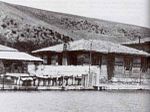Fil Bridge
Bridges completed in 1932Bridges in IstanbulEyüpGolden HornPedestrian bridges in Turkey ... and 2 more
Road bridges in TurkeyTied arch bridges
The Fil Bridge (Turkish: Fil Köprüsü), also known as Silahtarağa Bridge (Turkish: Silahtarağa Köprüsü) is a 38 m (125 ft) long, concrete bowstring bridge that crosses the Alibeyköy Creek in Istanbul, Turkey. The bridge was completed in 1932 by the Istanbul Metropolitan Municipality. The bridge is closed to automobile traffic, with the exception of motorcycles, and is a pedestrian bridge.
Excerpt from the Wikipedia article Fil Bridge (License: CC BY-SA 3.0, Authors).Fil Bridge
Silahtarağa Caddesi,
Geographical coordinates (GPS) Address Nearby Places Show on map
Geographical coordinates (GPS)
| Latitude | Longitude |
|---|---|
| N 41.068341 ° | E 28.943381 ° |
Address
Silahtarağa Caddesi
Silahtarağa Caddesi
34050
Türkiye
Open on Google Maps






